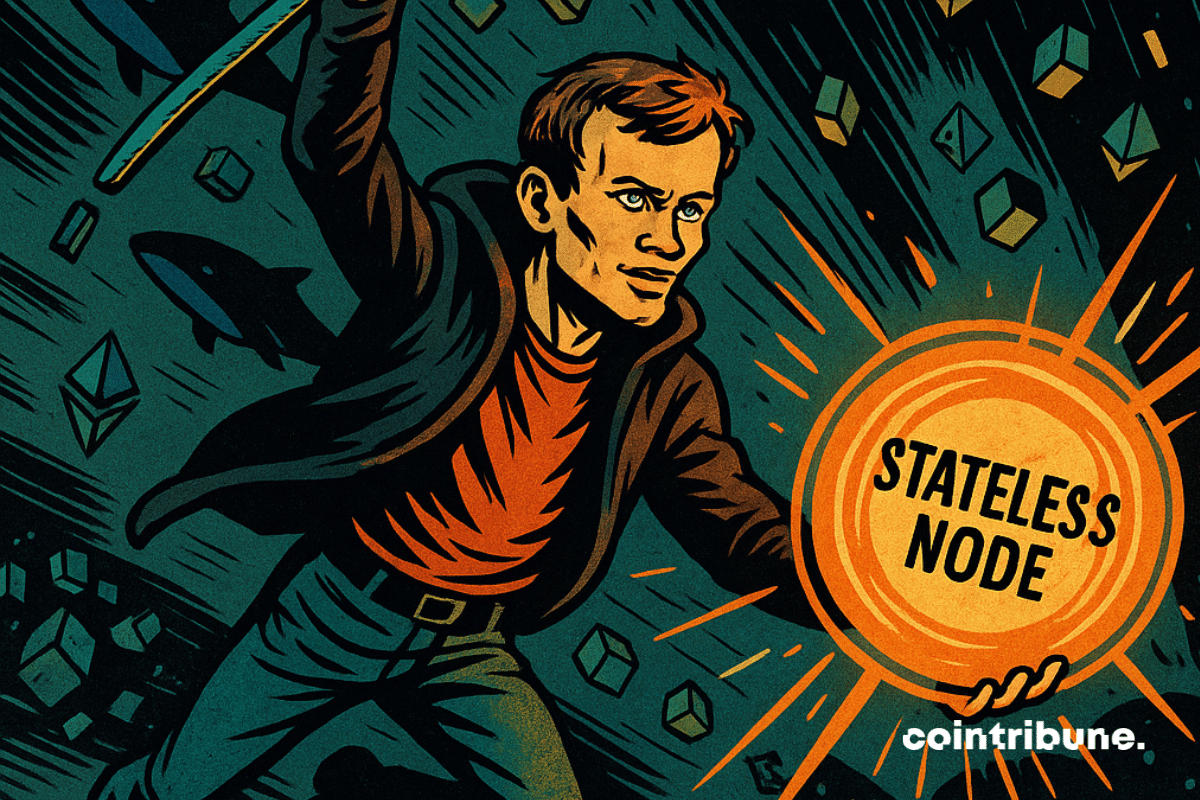17h05 ▪
5
min read ▪ by
Ethereum’s co-founder Vitalik Buterin is once again ringing the alarm on the network’s increasing complexity. In his latest reflections, Buterin laid out a fresh proposal urging the Ethereum community to make node operation easier for everyday users—warning that reliance on third-party access points could undermine the core principles of decentralization and privacy.
In Brief
- Buterin proposes simpler node use to protect trustless, independent access.
- New “partially stateless nodes” would allow users to store only relevant data.
- ETH price has dropped over 4% as whales cash out millions.
Buterin Calls for Stateless Nodes to Strengthen Ethereum
Most users today connect to Ethereum through external RPC (Remote Procedure Call) services provided by large firms. While convenient, this approach raises serious concerns. According to Buterin, these centralized services could be pressured to block users, censor certain transactions, or even become targets of surveillance. He argues that the current setup is making it harder for ordinary people to run their own local nodes—a challenge he now seeks to solve through a decisive decentralization plan.
Running a local node gives users direct, private access to Ethereum. It allows them to interact with decentralized applications and verify blockchain activity independently. But as Ethereum’s size balloons, running a full node has become too demanding for the average user, both in terms of storage and technical upkeep.
Vitalik believes Ethereum’s scaling roadmap has leaned too heavily on complex cryptographic solutions like ZK-EVMs (zero-knowledge Ethereum Virtual Machines), which allow for fast transaction validation. These technologies are useful, but they don’t solve the deeper issue: that Ethereum needs to be more accessible. In a recent proposal, he outlines a more local-node-friendly direction, insisting that full independence shouldn’t require expert knowledge or advanced hardware.
Towards a Simpler, Leaner Ethereum
To reverse the trend, Vitalik recommends fast-tracking EIP-4444—a proposal that would limit how much historical data nodes are required to store. If nodes only needed to keep about a month’s worth of history, it would significantly reduce their size, making it far easier for regular users to participate. To ensure old data isn’t lost, he suggests distributing storage across the network using erasure coding, where every node holds a small, recoverable piece of the puzzle.
He also proposes rebalancing Ethereum’s gas fee system. At the moment, it’s cheap to add new data to the chain—like launching new tokens or apps—but more expensive to run computations. Flipping this balance could help control Ethereum’s data growth, easing pressure on those running nodes.
A particularly novel idea is the creation of “partially stateless nodes.” These would validate blocks like full nodes but only keep the parts of the blockchain state that the user actually needs. Someone using Ethereum primarily for DeFi, for example, could configure their node to focus just on the relevant contracts and tokens.
Users could even automate these choices with a smart contract. This would allow someone to customize what their node tracks—making local nodes lighter, faster, and tailored to each person’s activity. It also reduces the need to rely on external services, helping return control to users.
ETH Price Drops as Whales Take Profits
While Vitalik is focused on long-term infrastructure, the market has shown some short-term jitters. Over the past 24 hours, Ethereum’s price has fallen more than 4%. The drop follows large profit-taking moves by whales, according to on-chain analytics platform Lookonchain.
One address reportedly offloaded 4,718 ETH worth $11.53 million—netting a profit of $3.18 million. Another wallet sold 2,594 ETH for around $6.23 million, gaining $1.31 million. These sales have fueled speculation that big players are cashing out amid ongoing network changes and uncertainty.
Ethereum Eyes the Future
This isn’t the first time this month that Vitalik Buterin has pushed for simplicity. Just weeks ago, he urged simplifying Ethereum’s Layer 1 design, pointing out that the network remains overly complex for many users.
His comments came just ahead of the Ethereum Foundation’s new Trillion Dollar Security Initiative. Unveiled on May 14th, the effort is focused on tightening Ethereum’s defenses as the network aims to become a key platform for global finance. The goal is to ensure Ethereum can securely support trillions of dollars in economic activity without compromising on decentralization or user control.
Maximize your Cointribune experience with our “Read to Earn” program! For every article you read, earn points and access exclusive rewards. Sign up now and start earning benefits.
Ifeoluwa specializes in Web3 writing and marketing, with over 5 years of experience creating insightful and strategic content. Beyond this, he trades crypto and is skilled at conducting technical, fundamental, and on-chain analyses.
DISCLAIMER
The views, thoughts, and opinions expressed in this article belong solely to the author, and should not be taken as investment advice. Do your own research before taking any investment decisions.










